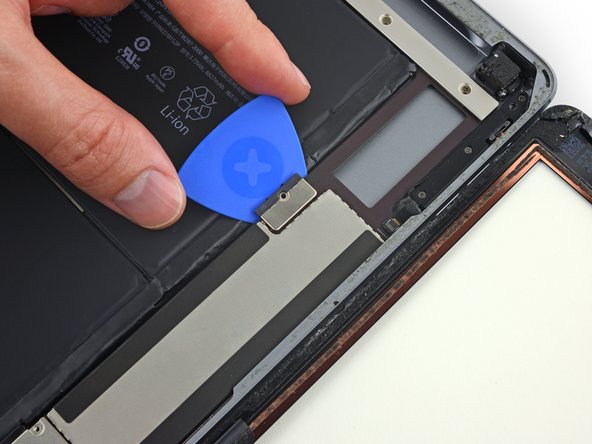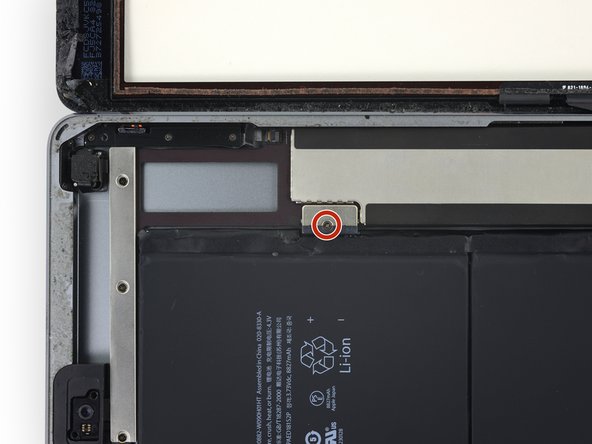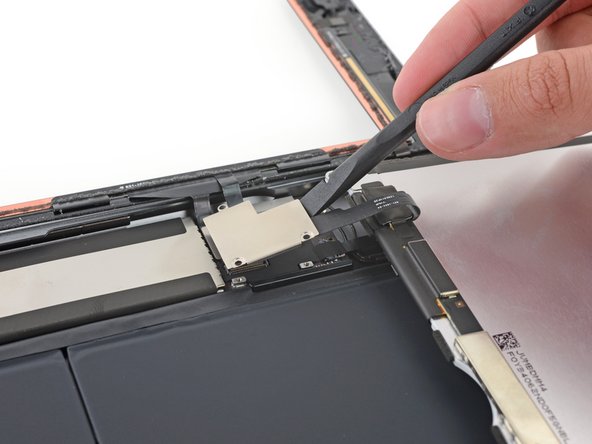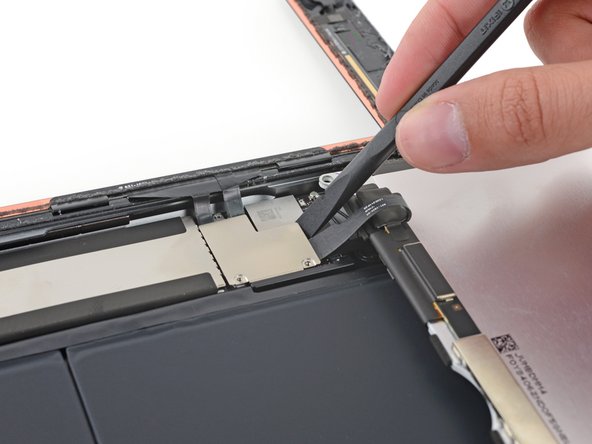iPad 6 Wi-Fi Microphone Assembly Replacement
Duration: 45 minutes
Steps: 51 Steps
Hey, take it nice and easy when you're isolating that battery with the blocker – let's keep things safe and smooth!
Hey, let's dive into swapping the microphone assembly in your iPad 6 Wi-Fi. Take it slow and steady when isolating the battery with a blocker—those contacts are super delicate and can really mess up the logic board if you're not careful. If you're ditching the blocker, skip the metal tools except for the essentials like removing screws, to keep the battery from shorting out and zapping the sensitive bits.
Step 1
- Warm up your iOpener and gently apply it to the left edge of the device for two minutes—you're doing great!
Tools Used
Step 2
- Hang tight while that adhesive loosens up—here are the spots that need a gentle touch to avoid any drama:
- Front camera
- Antennas
- Display cables
Step 3
The next three steps show off the Anti-Clamp, a handy tool we created to make popping open your device a breeze. If you don’t have an Anti-Clamp handy, just skip down three steps for another way to get the job done.
For the full scoop on using the Anti-Clamp, check out this guide.
If your iPad’s surface is feeling a bit too slick for the Anti-Clamp to grip, slap on some tape to give it a little extra hold.
- Pull the blue handle back to release the Anti-Clamp's arms—easy does it!
- Set something under your iPad so it sits nice and level between the suction cups.
- Place the suction cups near the center of the left edge—one up top, and one down low.
- Keep the bottom of the Anti-Clamp steady and press down firmly on the top cup to get a good seal.
Step 4
- Pull the blue handle forward to lock the arms in place. Easy, right?
- Now, give that handle a smooth 360-degree turn, or keep turning until you feel the cups start to stretch. No rush, just make sure it’s snug.
- Double-check the suction cups to make sure they’re still lined up. If they start drifting, loosen them up a bit, realign, and lock it back into place.
Step 5
Turn no more than half a click at a time, then chill for a minute. Let the Anti-Clamp and a little patience do the magic.
For the full rundown on using a hair dryer, check out this guide.
If the Anti-Clamp doesn't create a sufficient gap, apply more heat to the area and rotate the handle clockwise half a turn.
- Give it a minute—the adhesive is loosening up and creating a nice gap to work with.
- If the screen's not warming up enough, grab a hair dryer and gently heat along the left edge of your iPad.
- Once the Anti-Clamp has opened up a good gap, slide an opening pick under the digitizer.
- Skip the next step.
Step 6
If your screen is seriously cracked, a quick layer of clear packing tape might let the suction cup grab on. Or, swap in some super-strong tape instead. If that doesn't cut it, superglue the suction cup right to the busted screen. If you're feeling stuck, you can always schedule a repair.
- Warm up the screen until it's just right to the touch, then grab a suction handle and place it as close to the left edge as you can.
- Gently lift the screen using the suction handle, just enough to create a little gap between the digitizer and the frame.
- Slip an opening pick into that gap you've created and start working your magic!
Tools Used
Step 7
No need to stress if you spot the opening pick peeking through the digitizer—just pull it out gently. The LCD screen should be just fine, but be aware you might leave behind some adhesive that's a little tricky to clean off.
- Pop in a second opening pick right where you made that gap.
- Slide it gently toward the bottom-left corner of your device to loosen the adhesive.
- Leave the pick stuck in the corner to keep the adhesive from sealing back up.
Step 8
- If the opening pick gets stuck in the adhesive, just give it a little roll along the side of the iPad to help it break free and keep separating the adhesive like a pro.
Step 9
- Slide the first opening pick towards the top-left corner of your device to gently break the adhesive's grip.
- Once the pick is in the top-left corner, leave it there to keep the adhesive from sticking back together.
Step 10
- Grab an iOpener, heat it up, and let it work its magic on the top edge of your device for a solid two minutes.
Tools Used
Step 11
- Gently work the pick around the top-left corner of your device to loosen up that adhesive. Take it slow, no need to rush!
Step 12
Keep that pick away from the front camera to avoid messing up the lens. The steps ahead will show you how to steer clear of that.
- Gently slide the opening pick along the top edge of the device, but stop just before you hit that front camera. You don't want to accidentally give it a little bump!
Step 13
- Gently slide that pick out so just the tip's snug between the digitizer and frame – easy does it!
- Now, glide the pick right above the front camera to break up that sticky adhesive.
- Park the pick close to the right side of the front camera for now; we'll pick this up soon.
Step 14
- Slide that pick back in and guide it towards the top-right corner of the device to fully loosen the top adhesive.
- Leave the pick in the top-right corner to keep the adhesive from sticking back together.
Step 15
- Warm up your iOpener and press it gently along the right edge of the device for two minutes to get things loosening up nicely.
Tools Used
Step 16
- Gently rotate the pick around the top-right corner of your device. This will help separate the adhesive, and voilà, you're one step closer!
Step 17
The display cables are hanging out around the halfway point from the bottom of the iPad. Once you’re about three inches away from the bottom, stop sliding. You don’t want to go any further than that!
- Grab a fresh opening pick and slide it smoothly to the middle of the iPad's right edge.
Step 18
- Warm up your iOpener and let it hang out on the bottom edge of the device for about two minutes to loosen things up.
Tools Used
Step 19
Be careful not to rotate the pick too much around the corner – you don't want to accidentally mess with the antenna. Keep it steady and controlled.
- Slide the pick to the bottom-left corner, gently separating the adhesive as you go.
- Keep that pick in place at the bottom-left corner before moving forward to the next step.
Step 20
Slide the pick gently towards the home button, not away from it – we want to avoid any accidental antenna damage!
If you gotta slide the pick over this section again, just pop it out and slide it back in at the bottom-left corner.
- Gently pop a new opening pick into the tiny gap you just made along the bottom edge of your iPad.
- Slide the pick along, gliding over the antenna, and stop just shy of the home button.
- Pause with the pick resting to the left of the home button before moving on to the next step.
Step 21
Be careful when inserting the pick! Only go up to 1mm to keep the right antenna safe from damage.
- Pop that opening pick into the gap you just made.
- Gently slide the pick under the home button, aiming for the bottom-right corner, and make sure only the tip stays between the digitizer and the frame.
Step 22
Hey, glide that pick straight toward the home button—skip the detour, or you might mess up the antenna!
If you find yourself needing to slide the pick over this section once more, just pop it out and re-insert it starting from the bottom-right corner. It's an easy fix!
- Slip the pick back in and glide it towards the home button to fully detach the bottom adhesive.
- Keep the pick hanging out to the right of the home button for now.
Step 23
- Get your iOpener nice and toasty, then gently apply it to the right edge of the device for two minutes. Easy does it!
Tools Used
Step 24
Take your time with this step! Make sure the adhesive is nice and soft before you go for it. Use a pick to carefully separate everything. If you need a break or to reheat, don't worry—it's totally okay. Better safe than sorry!
Hey, if it's super stubborn, just warm up the edges again and gently glide your opening pick along them.
- Give those opening picks a gentle twist on the left corners of the iPad to lift the digitizer just a bit, peeling away that last bit of adhesive like it's no big deal!
Step 25
- Hey, lift that left edge of the digitizer up a bit – it'll help peel away the adhesive on the right side of your iPad!
Step 26
- Hold up the digitizer like a champ, then gently wiggle an opening pick between the two display cables to loosen the last stubborn bit of adhesive.
Step 27
- Once you've loosened all the sticky stuff, gently open the digitizer like a book and let it lie flat next to the iPad.
- When putting things back together, wipe off any leftover adhesive from the frame—and from the digitizer if you're reusing it—using some isopropyl alcohol. Then slap on new adhesive strips or pre-cut adhesive cards to keep everything snug.
- Keep an eye on those delicate display cables while reassembling. Make sure they’re tucked neatly under the LCD so nothing gets squished or damaged.
Step 28
- Hey, peel off any tape hiding those LCD screws – let's clear the way!
Step 29
- Snag those four Phillips #00 4.3 mm screws keeping the LCD secured.
Step 30
Hey, don't go pulling the LCD all the way out—it's still hooked up by a few cables near the home button. Just lift from the front camera end.
Take it slow and keep an eye on those LCD cables as you flip the display over.
Place the LCD gently on a soft, clean surface that’s free of lint. This will keep things smooth and scratch-free while you work your magic.
- Grab the flat side of your spudger and carefully pry the LCD just out of its spot enough to get a good grip with your fingers. Keep an eye out for any glue around the screw holes—you might need to slice it with a knife.
- Flip that iPad LCD like turning a page in a book, lifting near the camera and swinging it over to the home button end of the rear case.
- Lay the LCD face-down to make it easy to reach the display cables.
Tools Used
Step 31
Check out these photos to see what the battery connector looks like under the logic board. Use them as a guide while you carefully disconnect the battery.
You'll notice the battery connector has cantilever springs on the logic board that press against the battery's contact pads. Since both the logic board and battery are stuck in place, you'll need something thin and flexible to carefully slide between the contacts and safely disconnect the battery.
Step 32
To avoid causing a short circuit, grab a battery isolation pick to safely disconnect the battery.
Don't force the battery blocker under the connector. If it's not sliding in easily, try using a playing card instead to carefully disconnect the battery.
The battery blocker or playing card should smoothly slide under the logic board with no resistance. Once it's in, it should rest at a comfy 15-degree angle.
- Gently remove that single 2.3 mm Phillips #000 screw holding the battery connector to the logic board.
- Carefully slide the battery blocker underneath the logic board's battery connector at a smooth 35-degree angle.
- Keep the battery blocker in place as you keep things rolling.
Tools Used
Step 33
- Take out the three 1.4 mm Phillips #000 screws holding down the display cable bracket. You've got this!
Step 34
The display cable connector is stuck to the bottom of the bracket, so be gentle with that spudger! Don't go too deep or you might risk damaging the connector. Take your time and you'll be just fine.
- Grab the flat end of a spudger and gently lift the display cable bracket straight up from the logic board—take it slow and steady!
Tools Used
Step 35
- Let's carefully remove the LCD screen.
Step 36
- Peel off any tape that's covering the home button ribbon cable connector.
Step 37
- Grab your trusty spudger and use the flat end to gently lift the tab on the home button ribbon cable ZIF connector. No rush, just a little nudge.
- Now, carefully and steadily pull the home button ribbon cable straight out of the ZIF connector. Easy does it!
Tools Used
Step 38
Take care not to harm your iPad! Gently pry at the connectors, not the socket on the logic board. A little extra caution goes a long way!
- Grab the flat end of a spudger or use a fingernail, and gently lift the two digitizer cable connectors straight up from their sockets. Be careful, no need to rush!
- When putting everything back together, double-check that these connectors are snug in their sockets. If they’re not, you might run into display issues later on.
Tools Used
Step 39
- Gently lift the home button ribbon cable away from the adhesive that's sticking it to the back case. Take your time—this part’s all about a steady hand and a little patience.
Step 40
The insulation here is pretty sneaky – it won’t be visible to your eyes like the foam dust barrier strips you see in many iPads. It’s subtle but definitely there!
- Start by gently removing the front panel assembly.
- If you're having trouble with weird touch inputs (think ghostly phantom touches), no worries! Simply add a thin layer of insulating tape, like Kapton (polyimide) tape, to the highlighted areas on the back of the panel. Most panels should already come pre-insulated, so no extra tape should be needed. Easy, right?
- When the insulation's missing, the digitizer areas can touch other components and mess up your touch input. Keep things grounded, and your screen will behave!
Step 41
- Unscrew the three 1.4 mm Phillips #000 screws that are holding down the upper component cable bracket. You’ve got this!
Step 42
Hey, if you've got the Wi-Fi/Cellular iPad, it might look a bit different—chill, you'll just need to remove two extra screws to reach the components tucked under this bracket.
- Let's carefully remove the upper component cable bracket.
Step 43
Hey, just a heads up—only pry up on that connector, not the socket itself. Let's keep things smooth!
- Gently use the flat end of a spudger to pop off the front-facing camera connector from the logic board.
Tools Used
Step 44
Depending on how you removed the digitizer, this part might still be stuck to the inner side of the front panel. Take your time and be careful, or if you're feeling stuck, just schedule a repair and we'll handle it for you!
- Grab a spudger and gently work your way under the front-facing camera housing. Once you've loosened it, carefully lift it out of the case. Nice and easy – you got this!
Tools Used
Step 45
Between the front camera ribbon and the headphone jack cable, there's some conductive tape hanging out. When swapping out your front camera, just give a gentle push on the gold contacts to make sure those cables stick back in place.
- Gently slide a spudger under the front-facing camera to break it free from the adhesive holding it in place on the rear case.
- Carefully lift the front-facing camera out of the iPad.
Tools Used
Step 46
Gently lift the connector, not the socket itself. Give it a little wiggle if needed, but avoid forcing it—patience is key here!
- Gently use the flat end of your spudger to pop the headphone jack connector off the logic board.
- Carefully fold the headphone jack cable out of the way so it’s not in your repair zone.
Tools Used
Step 47
Hey, pry up on that connector gently—skip the socket to keep things chill!
- Grab the flat end of your spudger and gently pry the microphone cable connector off the logic board. Take it slow, no need to rush – the connection should pop free with just a little nudge!
Tools Used
Step 48
This will help loosen up the adhesive that's holding the microphone assembly in place, making it easier to remove.
- Place the top part of your iPad on the warmed-up iOpener, letting it relax and get comfy. This helps make the next step easier and smoother!
Tools Used
Step 49
- Gently slide the flat end of a spudger between the case and the microphone cable. You got this!
- Carefully peel the lower part of the microphone cable off the case, like you're unwrapping a present. Easy does it!
Tools Used
Step 50
- Hey, grab that spudger and gently lift the fragile top end of the microphone cable from the sticky adhesive on the rear case.
Tools Used
Step 51
- Alright, time to put everything back together! Just follow these steps in reverse order, and you'll be good to go. If you need a hand, you can always schedule a repair.
































































































































